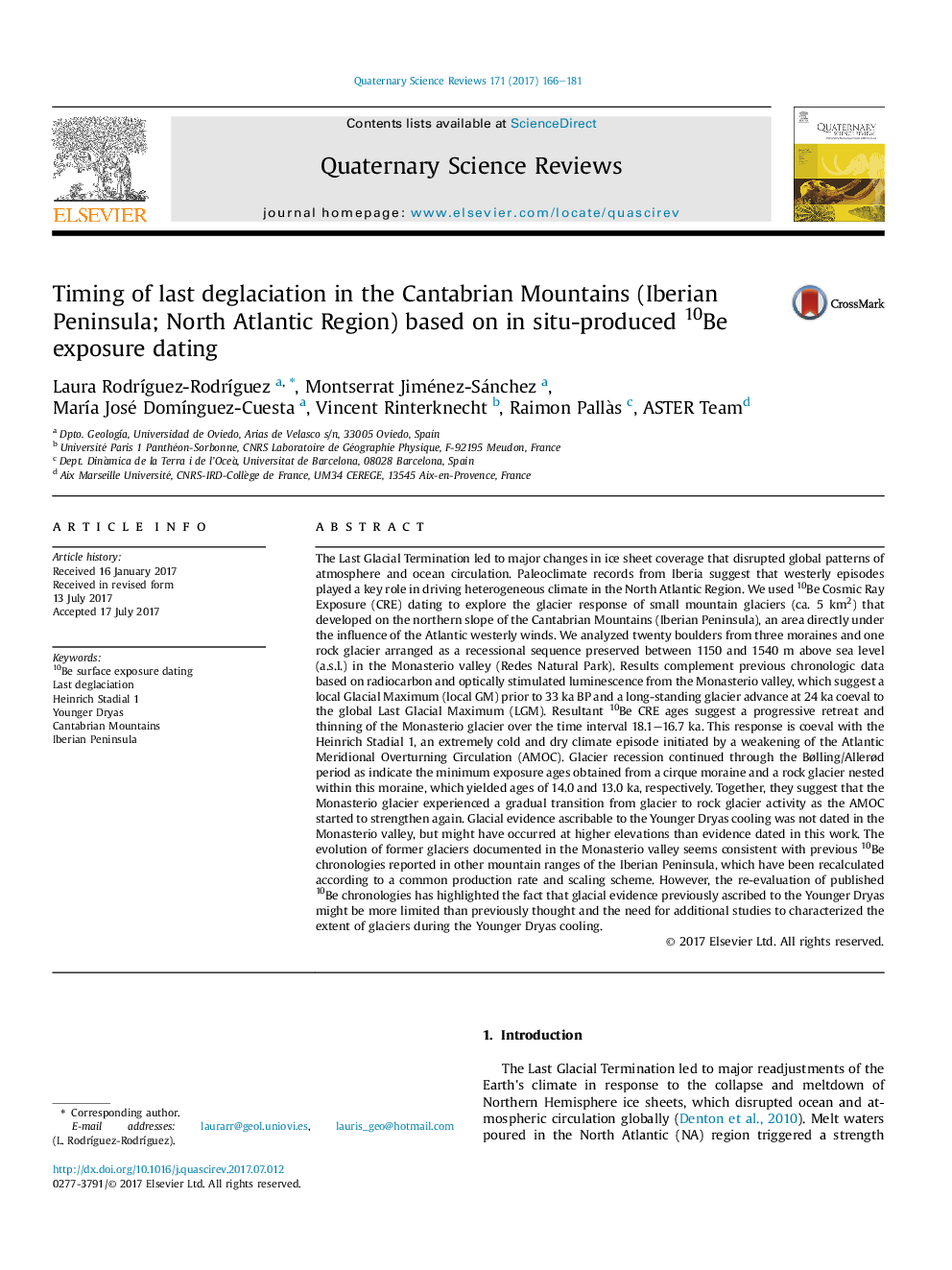| کد مقاله | کد نشریه | سال انتشار | مقاله انگلیسی | نسخه تمام متن |
|---|---|---|---|---|
| 5786594 | 1640764 | 2017 | 16 صفحه PDF | دانلود رایگان |
عنوان انگلیسی مقاله ISI
Timing of last deglaciation in the Cantabrian Mountains (Iberian Peninsula; North Atlantic Region) based on in situ-produced 10Be exposure dating
ترجمه فارسی عنوان
زمان بندی آخرین دفع زباله در کوه های کانتربری (شبه جزیره ایبرین، منطقه اقیانوس اطلس شمالی) بر پایه سفارشی سازی مواجهه شده با محیط زیست 10
دانلود مقاله + سفارش ترجمه
دانلود مقاله ISI انگلیسی
رایگان برای ایرانیان
کلمات کلیدی
موضوعات مرتبط
مهندسی و علوم پایه
علوم زمین و سیارات
زمین شناسی
چکیده انگلیسی
The Last Glacial Termination led to major changes in ice sheet coverage that disrupted global patterns of atmosphere and ocean circulation. Paleoclimate records from Iberia suggest that westerly episodes played a key role in driving heterogeneous climate in the North Atlantic Region. We used 10Be Cosmic Ray Exposure (CRE) dating to explore the glacier response of small mountain glaciers (ca. 5 km2) that developed on the northern slope of the Cantabrian Mountains (Iberian Peninsula), an area directly under the influence of the Atlantic westerly winds. We analyzed twenty boulders from three moraines and one rock glacier arranged as a recessional sequence preserved between 1150 and 1540 m above sea level (a.s.l.) in the Monasterio valley (Redes Natural Park). Results complement previous chronologic data based on radiocarbon and optically stimulated luminescence from the Monasterio valley, which suggest a local Glacial Maximum (local GM) prior to 33 ka BP and a long-standing glacier advance at 24 ka coeval to the global Last Glacial Maximum (LGM). Resultant 10Be CRE ages suggest a progressive retreat and thinning of the Monasterio glacier over the time interval 18.1-16.7 ka. This response is coeval with the Heinrich Stadial 1, an extremely cold and dry climate episode initiated by a weakening of the Atlantic Meridional Overturning Circulation (AMOC). Glacier recession continued through the Bølling/Allerød period as indicate the minimum exposure ages obtained from a cirque moraine and a rock glacier nested within this moraine, which yielded ages of 14.0 and 13.0 ka, respectively. Together, they suggest that the Monasterio glacier experienced a gradual transition from glacier to rock glacier activity as the AMOC started to strengthen again. Glacial evidence ascribable to the Younger Dryas cooling was not dated in the Monasterio valley, but might have occurred at higher elevations than evidence dated in this work. The evolution of former glaciers documented in the Monasterio valley seems consistent with previous 10Be chronologies reported in other mountain ranges of the Iberian Peninsula, which have been recalculated according to a common production rate and scaling scheme. However, the re-evaluation of published 10Be chronologies has highlighted the fact that glacial evidence previously ascribed to the Younger Dryas might be more limited than previously thought and the need for additional studies to characterized the extent of glaciers during the Younger Dryas cooling.
ناشر
Database: Elsevier - ScienceDirect (ساینس دایرکت)
Journal: Quaternary Science Reviews - Volume 171, 1 September 2017, Pages 166-181
Journal: Quaternary Science Reviews - Volume 171, 1 September 2017, Pages 166-181
نویسندگان
Laura RodrÃguez-RodrÃguez, Montserrat Jiménez-Sánchez, MarÃa José DomÃnguez-Cuesta, Vincent Rinterknecht, Raimon Pallà s,
